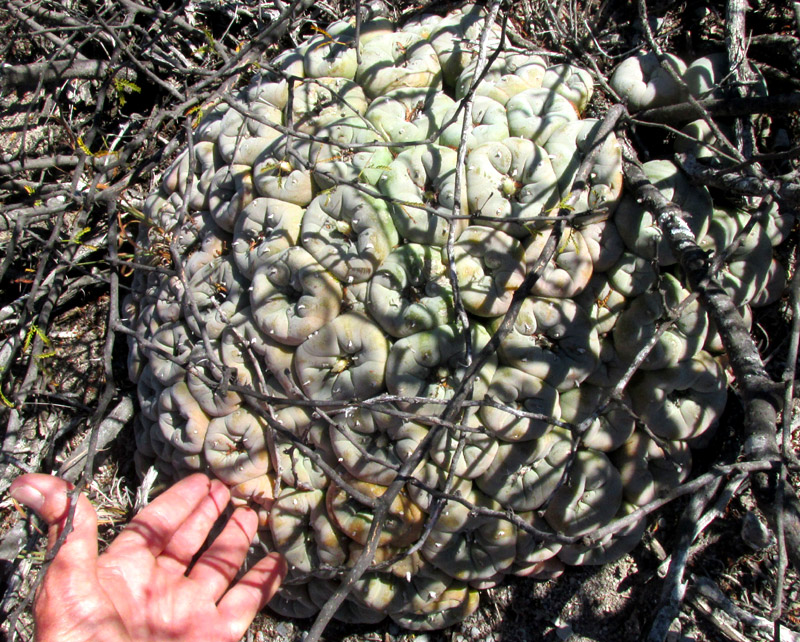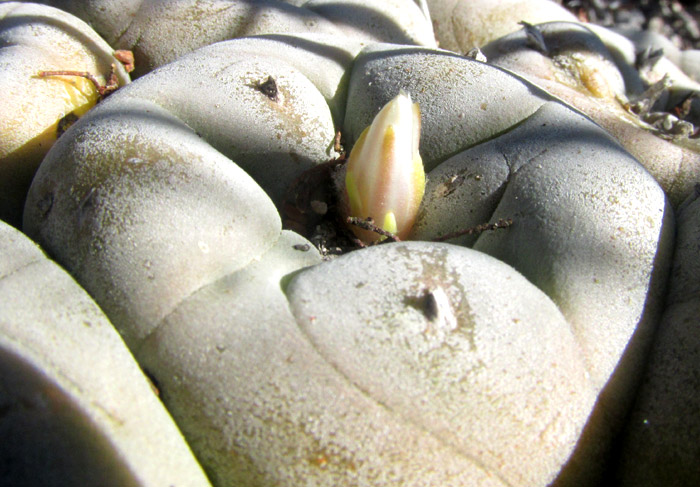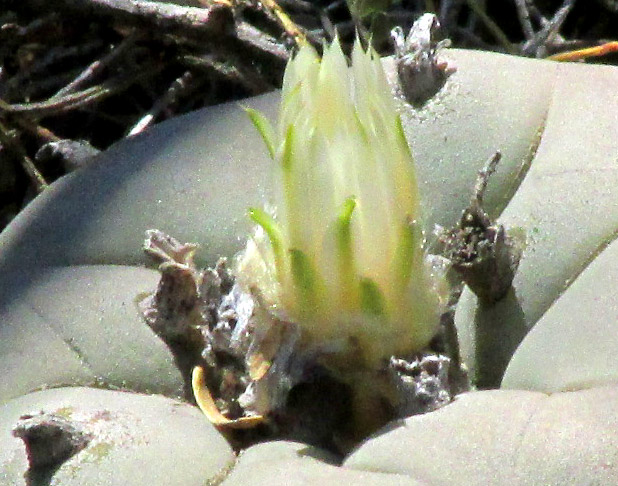Excerpts from Jim Conrad's
Naturalist Newsletter
Entry dated March 12, 2024, from notes taken in semidesert among mountains around Higuerillas, Municipality of Cadereyta de Montes; N20.90°, W99.78°, elevation ~1660 meters (~5450 feet); central Querétaro state, MÉXICO
FALSE PEYOTE

I'd never seen or heard of a Peyote cactus as large as the one above, sheltering below a spiny shrub. Also, its general form seemed different. Don't smaller plants usually surround the larger ones, and aren't the cactus's individual tubercles with their star-shaped pleats more separated from one another, and smaller?

Numerous plants were found, some comprising only three or four tubercles, and the tubercles of most clusters issued no flower buds. Above, a flower bud arises from the center of a tubercle.

In the whole population, only the above tubercle produced a flower which was at least partially open.

Most tubercles on most plants bore no spines. The above is the best-formed spine I could find, which was hardly a spine at all. That picture also shows how the tubercles were covered with tiny, silvery scales.
Until now, I'd not realized that more than one species of Peyote exists, and that the natural distribution of the most famous species, Lophophora williamsii, doesn't extend this far south into central Mexico. Here in Querétaro state, only one Peyote species occurs, and that's LOPHOPHORA DIFFUSA. Pictures of that species match ours, though so far I find no images of individuals nearly as large as the plant atop this page.
In Mexico, including this area, Lophophora diffusa is simply known as Peyote. However, publications in English distinguishing the Lophophora species tend to call our plant False Peyote, since it's not the more famous, more northern, and much more widely distributed Lophophora williamsii. Moreover, the taxonomy of Lophophora species is unsettled. At this writing, Kew's Plants of the Word Online database recognizes the Peyote genus Lophophora as comprising four species: Lophophora alberto-vojtechii, L. diffusa, L. fricii and the famous L. williamsii.
With regard to plants sometimes known as Lophophora diffusa ssp. kubesae, as well as plants known as Lophophora diffusa ssp. viridescens, Kew considers these just as forms of our Lophophora diffusa, having no taxonomic status. However, plants sometimes known as Lophophora diffusa ssp. fricii are recognized by Kew as a distinct species, Lophophora fricii. As such, Kew says that the native distribution of our Lophophora diffusa is limited to a small part of highland central Mexico's Querétaro state, and across the border into Hidalgo state. Other references limit the species just to this west-central part of Querétaro state.
The IUCN Red List categorizes our Lophophora diffusa as threatened with extinction in the wild, explaining that only about 3000 mature individual Lophophora diffusa plants are known to exist in the wild, that the population is severely fragmented, and that the populations are experiencing a continuing decline. The Red List page for the species tells us that "The species is threatened by illegal collecting and use by indigenous people for medicine, and by collectors for ornamental trade." Collectors sell the plant locally as a narcotic. The species is illegal to keep in cultivation, resulting in increased demand and more robbery of plants from the wild.
Note that I am vague as to our plant's precise location, and even as to the specific habitat. Commercial collectors are well aware where the various Lophophora species are found, and on the Internet and in books precise locations are given, much to the determent of the species.
In the famous Lophophora williamsii, the main chemical alkaloid causing altered states of awareness is mescaline. Our Lophophora diffusa contains zero to trace amounts of mescaline. However, our plants do contain the alkaloid pellotine, which is slightly narcotic, accounting for the local overcollecting of the species. Wikipedia's Pellotine page tells us that "When injected subcutaneously to humans, participants have reported drowsiness and a desire not to exert any physical or mental effort with one study reporting it to have hypnotic effects." Also it may lower blood pressure and heart rate.
Cacti of the Peyote genus Lophophora are so unusual that even if you're familiar with the various genera's differing morphology, the Peyote plant's structure may be hard to understand. The bodies of some genera, such as that of the Giant Barrel Cactus, exhibit vertical ridges. Other genera, such as that of Gaumer's Mammillaria, manifest roundish, nipple-like mounds, the tubercles, with each tubercle producing one or more spines. Peyote cacti are like a mammillaria squeezed from the top to produce low, hemispheric plants with crowded, flat-topped tubercles.